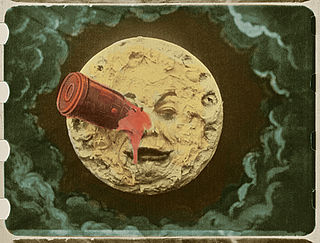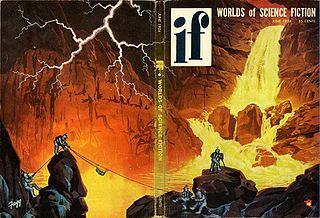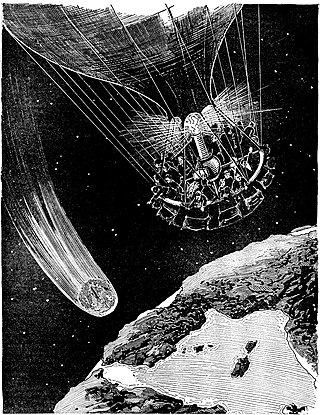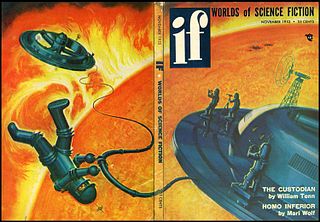
Supernovae, extremely powerful explosions of stars, have been featured in works of fiction since at least the early 1900s.

Supernovae, extremely powerful explosions of stars, have been featured in works of fiction since at least the early 1900s.
A supernova is a type of stellar event wherein a star explodes, releasing enormous amounts of energy in a short period of time. While a nova is strictly speaking a different type of astronomical event, science fiction writers often use the terms interchangeably and refer to stars "going nova" without further clarification; this can at least partially be explained by the earliest science fiction works featuring these phenomena predating the introduction of the term "supernova" as a separate class of event in 1934. [1] [2] [3]
The prospect of the Sun exploding in this manner has been used in several disaster stories. [2] [4] [5] It was recognized early on that the immense destructive power of such an event would leave little to no hope of survival for humanity, and so while Simon Newcomb's 1903 short story "The End of the World" depicts a few survivors in the immediate aftermath, [2] [6] Hugh Kingsmill's 1924 short story also entitled "The End of the World" instead focuses on the anticipation of the destruction of the Earth. [4] [7] According to science fiction writer Brian Stableford, writing in the 2006 work Science Fact and Science Fiction: An Encyclopedia , it was thus not until the concept of space travel became widespread in science fiction—hence making evacuation of the Earth a conceivable prospect—that such stories became popular. [2] In John W. Campbell's 1930 short story "The Voice of the Void" humanity leaves Earth ahead of this disaster, [2] [8] while in Joseph W. Skidmore 's 1931 short story "Dramatis Personae" the Sun explodes without warning, leaving a few people already in spaceships as the only survivors. [2] [9] Rescue missions by aliens are sent to Earth in Raymond Z. Gallun's 1935 short story "Nova Solis" and Arthur C. Clarke's 1946 short story "Rescue Party", though in the latter they discover that evacuation has already been undertaken. [2] [10] The Sun exploding occasionally appears as a background event to explain why humanity has abandoned Earth in favour of colonizing the cosmos, [3] one example being Theodore Sturgeon's 1956 short story "The Skills of Xanadu". [2] [11] Clarke's 1958 short story "The Songs of Distant Earth" (later expanded into a 1986 novel bearing the same title) revolves around an encounter between humans who leave Earth shortly before the explosion of the Sun and the members of a centuries-old extrasolar colony. [2] [3] George O. Smith's 1958 novel Fire in the Heavens revisits the theme of anticipating the end of the world as a result of an impending solar explosion, [2] [12] and in Larry Niven's 1971 short story "Inconstant Moon", the sudden brightening of the Moon in the night sky leads the characters to conclude that the Sun has already exploded and will imminently destroy all human life on Earth. [4] [5] [13]
It is now recognized that the Sun cannot turn into a supernova (or nova) as the necessary stellar conditions are not met. [1] [3] [14] Earth is nevertheless threatened by the radiation from more distant supernovae in several works. [3] [5] [14] In Richard Cowper's 1974 novel The Twilight of Briareus , a supernova some 100 light-years distant causes a radical shift in the Earth's climate, ushering in a new ice age, [2] [14] [15] while in Ian Watson's 1977 short story "The Roentgen Refugees", Sirius going supernova a mere 9 light-years away sterilizes the entire surface of the Earth. [14] Another supernova in the Sirius system appears in Roger MacBride Allen and Eric Kotani's 1991 novel Supernova , [2] [3] [5] and one in the Alpha Centauri system threatens Earth in Charles Sheffield's 1998 novel Aftermath . [5] [16]
Besides humans, alien civilizations are also subject to the dangers of supernovae in some stories. [3] In Clarke's 1955 short story "The Star", an alien species is found to have gone extinct some two millennia ago when their star exploded, creating the biblical Star of Bethlehem. [1] [2] [3] [5] In Poul Anderson's 1967 short story "Day of Burning" (a.k.a. "Supernova"), humans try to evacuate a planet inhabited by a pre-spacefaring society threatened by a supernova. [2] [5] [16] In Stephen Tall's 1971 short story "The Bear with the Knot on His Tail", such a rescue mission is complicated by the language barrier between the humans and the imperiled aliens. [2] [17] The explosion of its star is also the cause of the planet Krypton's destruction in some iterations of the Superman franchise. [3]
Since these stellar explosions release enormous amounts of energy, some stories propose using them as a power source for extremely energy-intense processes, such as time travel in the Doctor Who serial The Three Doctors from 1972. [1] For the same reason, inducing them is occasionally portrayed as a potential weapon, for instance in the 1966 novel The Solarians by Norman Spinrad. [2] [4]


Mars, the fourth planet from the Sun, has appeared as a setting in works of fiction since at least the mid-1600s. Trends in the planet's portrayal have largely been influenced by advances in planetary science. It became the most popular celestial object in fiction in the late 1800s, when it became clear that there was no life on the Moon. The predominant genre depicting Mars at the time was utopian fiction. Around the same time, the mistaken belief that there are canals on Mars emerged and made its way into fiction, popularized by Percival Lowell's speculations of an ancient civilization having constructed them. The War of the Worlds, H. G. Wells's novel about an alien invasion of Earth by sinister Martians, was published in 1897 and went on to have a major influence on the science fiction genre.

The Moon has appeared in fiction as a setting since at least classical antiquity. Throughout most of literary history, a significant portion of works depicting lunar voyages has been satirical in nature. From the late 1800s onwards, science fiction has successively focused largely on the themes of life on the Moon, first Moon landings, and lunar colonization.

Fictional depictions of Mercury, the innermost planet of the Solar System, have gone through three distinct phases. Before much was known about the planet, it received scant attention. Later, when it was incorrectly believed that it was tidally locked with the Sun creating a permanent dayside and nightside, stories mainly focused on the conditions of the two sides and the narrow region of permanent twilight between. Since that misconception was dispelled in the 1960s, the planet has again received less attention from fiction writers, and stories have largely concentrated on the harsh environmental conditions that come from the planet's proximity to the Sun.

Jupiter, the largest planet in the Solar System, has appeared in works of fiction across several centuries. The way the planet has been depicted has evolved as more has become known about its composition; it was initially portrayed as being entirely solid, later as having a high-pressure atmosphere with a solid surface underneath, and finally as being entirely gaseous. It was a popular setting during the pulp era of science fiction. Life on the planet has variously been depicted as identical to humans, larger versions of humans, and non-human. Non-human life on Jupiter has been portrayed as primitive in some works and more advanced than humans in others.

Saturn has made appearances in fiction since the 1752 novel Micromégas by Voltaire. In the earliest depictions, it was portrayed as having a solid surface rather than its actual gaseous composition. In many of these works, the planet is inhabited by aliens that are usually portrayed as being more advanced than humans. In modern science fiction, the Saturnian atmosphere sometimes hosts floating settlements. The planet is occasionally visited by humans and its rings are sometimes mined for resources.

Pluto has appeared in fiction as a setting since shortly after its 1930 discovery, albeit infrequently. It was initially comparatively popular as it was newly discovered and thought to be the outermost object of the Solar System and made more fictional appearances than either Uranus or Neptune, though still far fewer than other planets. Alien life, sometimes intelligent life and occasionally an entire ecosphere, is a common motif in fictional depictions of Pluto. Human settlement appears only sporadically, but it is often either the starting or finishing point for a tour of the Solar System. It has variously been depicted as an originally extrasolar planet, the remnants of a destroyed planet, or entirely artificial. Its moon Charon has also appeared in a handful of works.

Asteroids have appeared in fiction since at least the late 1800s, the first one—Ceres—having been discovered in 1801. They were initially only used infrequently as writers preferred the planets as settings. The once-popular Phaëton hypothesis, which states that the asteroid belt consists of the remnants of the former fifth planet that existed in an orbit between Mars and Jupiter before somehow being destroyed, has been a recurring theme with various explanations for the planet's destruction proposed. This hypothetical former planet is in science fiction often called "Bodia" in reference to Johann Elert Bode, for whom the since-discredited Titius–Bode law that predicts the planet's existence is named.

Neptune has appeared in fiction since shortly after its 1846 discovery, albeit infrequently. It initially made appearances indirectly—e.g. through its inhabitants—rather than as a setting. The earliest stories set on Neptune itself portrayed it as a rocky planet rather than as having its actual gaseous composition; later works rectified this error. Extraterrestrial life on Neptune is uncommon in fiction, though the exceptions have ranged from humanoids to gaseous lifeforms. Neptune's largest moon Triton has also appeared in fiction, especially in the late 20th century onwards.

Uranus has been used as a setting in works of fiction since shortly after its 1781 discovery, albeit infrequently. The earliest depictions portrayed it as having a solid surface, whereas later stories portrayed it more accurately as a gaseous planet. Its moons have also appeared in a handful of works. Both the planet and its moons have experienced a slight trend of increased representation in fiction over time.
In science fiction, a time viewer, temporal viewer, or chronoscope is a device that allows another point in time to be observed. The concept has appeared since the late 19th century, constituting a significant yet relatively obscure subgenre of time travel fiction and appearing in various media including literature, cinema, and television. Stories usually explain the technology by referencing cutting-edge science, though sometimes invoking the supernatural instead. Most commonly only the past can be observed, though occasionally time viewers capable of showing the future appear; these devices are sometimes limited in terms of what information about the future can be obtained. Other variations on the concept include being able to listen to the past but not view it.
The fictional portrayal of the Solar System has often included planets, moons, and other celestial objects which do not actually exist. Some of these objects were, at one time, seriously considered as hypothetical planets which were either thought to have been observed, or were hypothesized to be orbiting the Sun in order to explain certain celestial phenomena. Often such objects continued to be used in literature long after the hypotheses upon which they were based had been abandoned.
Planets outside of the Solar System have been featured as settings in works of fiction. Most of these fictional planets do not vary significantly from the Earth. Exceptions include planets with sentience, planets without stars, and planets in multiple-star systems where the orbital mechanics can lead to exotic day–night or seasonal cycles.
Phaeton was the hypothetical planet hypothesized by the Titius–Bode law to have existed between the orbits of Mars and Jupiter, the destruction of which supposedly led to the formation of the asteroid belt. The hypothetical planet was named for Phaethon, the son of the sun god Helios in Greek mythology, who attempted to drive his father's solar chariot for a day with disastrous results and was ultimately destroyed by Zeus.
Stars outside of the Solar System have been featured as settings in works of fiction since at least the 1600s.

The Tunguska event—an enormous explosion in a remote region of Siberia on 30 June 1908—has appeared in many works of fiction.
Black holes, objects whose gravity is so strong that nothing including light can escape them, have been depicted in fiction since before the term was coined by John Archibald Wheeler in the late 1960s. Black holes have been depicted with varying degrees of accuracy to the scientific understanding of them. Because what lies beyond the event horizon is unknown and by definition unobservable from outside, authors have been free to employ artistic license when depicting the interiors of black holes.

Comets have appeared in works of fiction since at least the 1830s. They primarily appear in science fiction as literal objects, but also make occasional symbolical appearances in other genres. In keeping with their traditional cultural associations as omens, they often threaten destruction to Earth. This commonly comes in the form of looming impact events, and occasionally through more novel means such as affecting Earth's atmosphere in different ways. In other stories, humans seek out and visit comets for purposes of research or resource extraction. Comets are inhabited by various forms of life ranging from microbes to vampires in different depictions, and are themselves living beings in some stories.
"Message from space" is a type of "first contact" theme in science fiction. Stories of this type involve receiving an interstellar message which reveals the existence of other intelligent life in the universe.

The Sun has appeared as a setting in fiction at least since classical antiquity, but for a long time it received relatively sporadic attention. Many of the early depictions viewed it as an essentially Earth-like and thus potentially habitable body—a once-common belief about celestial objects in general known as the plurality of worlds—and depicted various kinds of solar inhabitants. As more became known about the Sun through advances in astronomy, in particular its temperature, solar inhabitants fell out of favour save for the occasional more exotic alien lifeforms. Instead, many stories focused on the eventual death of the Sun and the havoc it would wreak upon life on Earth. Before it was understood that the Sun is powered by nuclear fusion, the prevailing assumption among writers was that combustion was the source of its heat and light, and it was expected to run out of fuel relatively soon. Even after the true source of the Sun's energy was determined in the 1920s, the dimming or extinction of the Sun remained a recurring theme in disaster stories, with occasional attempts at averting disaster by reigniting the Sun. Another common way for the Sun to cause destruction is by exploding, and other mechanisms such as solar flares also appear on occasion.

Impact events have been a recurring theme in fiction since the 1800s.